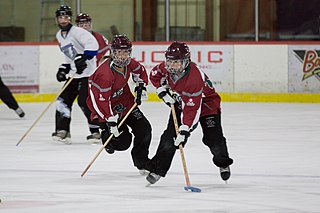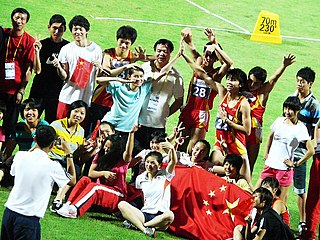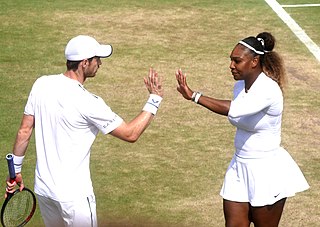
Title IX is the most commonly used name for the federal civil rights law in the United States that was enacted as part of the Education Amendments of 1972. It prohibits sex-based discrimination in any school or any other education program that receives funding from the federal government. This is Public Law No. 92‑318, 86 Stat. 235, codified at 20 U.S.C. §§ 1681–1688.

The participation of women and girls in sports, physical fitness and exercise, has been recorded to have existed throughout history. However, participation rates and activities vary in accordance with nation, era, geography and stage of economic development. While initially occurring informally, the modern era of organized sports did not begin to emerge either for men or women until the late industrial age.
Achievement gaps in the United States are observed, persistent disparities in measures of educational performance among subgroups of U.S. students, especially groups defined by socioeconomic status (SES), race/ethnicity and gender. The achievement gap can be observed through a variety of measures, including standardized test scores, grade point average, dropout rates, college enrollment, and college completion rates. The gap in achievement between lower income students and higher income students exists in all nations and it has been studied extensively in the U.S. and other countries, including the U.K. Various other gaps between groups exist around the globe as well.

College athletics in the United States or college sports in the United States refers primarily to sports and athletic training and competition organized and funded by institutions of tertiary education.
Volleyball in the United States is popular with both male and female participants of all ages. Almost all high schools and colleges in the United States have female volleyball teams, and most regions of the country have developmental programs for girls of all ages as well. While many areas of the country are forming male teams and development programs, there are still fewer opportunities for young male athletes to play volleyball in the United States than for young female athletes. Men's volleyball is a fast-growing sport among high schools, with 36 states having male volleyball programs. Most men's seasons are in the spring while women's seasons take place primarily in the fall; however, there are a few men's teams such as in Wisconsin, Virginia, and New York who play in the fall as well.

The Women's Sports Foundation (WSF) is a 501(c)(3) educational nonprofit charity focused on female involvement in sports. Founded in 1974 by tennis player Billie Jean King and initially supported by Olympic athletes Donna de Varona and Suzy Chaffee, its stated mission statement is "To advance the lives of girls and women through sports and physical activity."
Michael Alan Messner is an American sociologist. His main areas of research are gender and the sociology of sports. He is the author of several books, he gives public speeches and teaches on issues of gender-based violence, the lives of men and boys, and gender and sports.

The Missouri State High School Activities Association (MSHSAA) is the governing body for high school activities throughout the state of Missouri. Approximately 580 high schools are members of MSHSAA.

Sex differences in education are a type of sex discrimination in the education system affecting both men and women during and after their educational experiences. Men are more likely to be literate on a global average, although higher literacy scores for women are prevalent in many countries. Women are more likely to achieve a tertiary education degree compared to men of the same age. Men tended to receive more education than women in the past, but the gender gap in education has reversed in recent decades in most Western countries and many non-Western countries.

The feminization of the workplace is the feminization, or the shift in gender roles and sex roles and the incorporation of women into a group or a profession once dominated by men, as it relates to the workplace. It is a set of social theories seeking to explain occupational gender-related discrepancies.
Women's sport in Australia started in the colonial era. Sport made its way into the school curriculum for girls by the 1890s. World War II had little impact on women's sport in the country. After the war, women's sport diversified as a result of new immigrants to the country. In the 1990s, the percentage of media coverage for women's sport on radio, television and in newspapers was not at parity with male sport. Basketball is nominally professional in Australia but players do not earn enough from the sport to compete full-time. Some Australians have gone overseas to play professional sport. Many television spectators for Australian sport are women. In person, netball has large percentage of female spectators. The Australian Federal and State governments have encouraged women to participate in all areas of sport.

Youth sports is any sports event where competitors are younger than adult age, whether children or adolescents. Youth sports includes school sports at primary and secondary level, as well as sports played outside the education system, whether informally or organized.
Women's education in Pakistan is a fundamental right of every female citizen, according to article thirty-seven of the Constitution of Pakistan, but gender discrepancies still exist in the educational sector. According to the 2011 Human Development Report of the United Nations Development Program, approximately twice as many males as females receive a secondary education in Pakistan, and public expenditures on education amount to only 2.7% of the GDP of the country. The unemployment rate of female graduates in Pakistan is approximately 3.8 times higher than that of their male counterparts.
Misogyny in sports refers to different discourses, actions, and ideologies present in various sporting environments that add, reinforce, or normalize the objectification, degrading, shaming, or absence of women in athletics.
The participation of transgender people in competitive sports, a traditionally sex-segregated institution, is a controversial issue, particularly the inclusion of transgender women and girls in women's sports.

Modern Muslim female athletes have achieved success in a variety of sports, including volleyball, tennis, association football, fencing, and basketball. In the 2016 Summer Olympics, fourteen women from Muslim-majority countries won medals, participating in a wide range of sports.

Gender pay gap in sports is the persistence of unequal pay in sports, particularly for female athletes who do not receive equal revenue compared to their counterparts, which differs depending on the sport. According to the research conducted by BBC, "a total of 83% of sports now reward men and women equally". However, it does not mean that the wage gap in sports has narrowed or disappeared. In 2018, Forbes released the list of the top 100 highest-paid athletes, all of them being male athletes. A similar situation also occurred in 2017, where there was only one female athlete – tennis player Serena Williams — who joined the list and ranked No.56. Billie Jean King brought awareness to the issue of unequal pay in the early 1970s, when she was awarded $2,900 less than her male counterpart at the Italian Open. The timeline of the gender pay gap in sports displays the significant events that have occurred since the 1970s.

The gender gap in Pakistan refers to the differences between men and women in Pakistan in terms of social, political, and economic participation and rights. The gender gap uses the gender ratio of Pakistan to compare the disparities between men and women in different fields, which mainly disadvantage women. According to the Global Gender Gap Index 2022, Pakistan ranks second to last in terms of the Gender Gap, with only 56.4% of its gender gap closed, a 0.8 percentage point increase from 2021. By percentage, men form about 51.46% and women form about 48.54% of the total population of Pakistan. The sex ratio of Pakistan is 106.010, that means there are about 106 men for every 100 women in Pakistan. The gender gap in Pakistan includes comparisons of gender differences in health, educational, legal, economical, and political aspects.
Misogyny in ice hockey refers to the discourses, actions, and ideologies which are present in ice hockey, environments which contribute to the discrimination against women in the sport as well as their absence from it. This phenomenon includes issues related to sexism and male chauvinism. The subject has been extensively discussed in both media and academia, with many women in the sport increasingly speaking out about the extent of misogyny in hockey and its negative impact on the sport.
The Fairness In Women's Sports Act is a common title for legislation passed in Idaho, Florida, and Arkansas that restricts participation in interscholastic, intercollegiate, intramural, club athletic teams, and any sports sponsored by a public school or university based on the biological sex of the individual. The legislation was introduced in response to concerns that allowing transgender females to compete in women's sports would create an unfair advantage due to their physiological differences. Legislation of this nature has been introduced in several states across the US and is part of a national debate over whether transgender athletes should be allowed to compete in sports teams based on their gender identity. Supporters of the laws argue that it is necessary to maintain fair competition and protect the integrity of women's sports, while opponents argue that they are discriminatory and unjust. Much of the current legislation is facing legal challenges and criticism from advocates for transgender rights, who argue that they perpetuate harmful stereotypes and ignore the diversity of gender identities.














